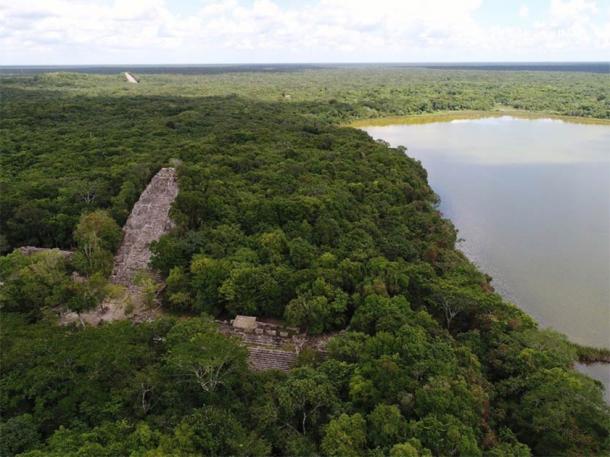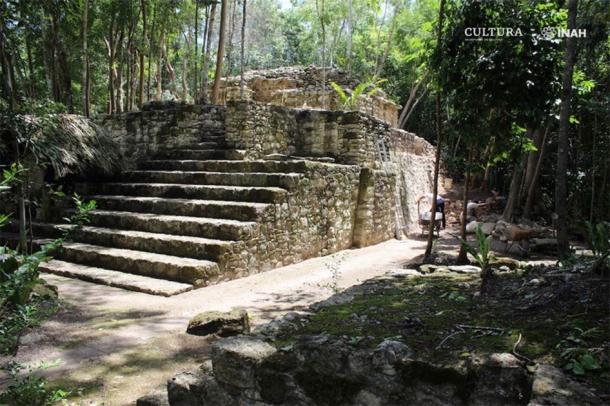The Maya city of Cobá, in Mexico’s Yucatán Peninsula, is a spectacular spread of tree-locked pyramid-temples and raised causeways connecting strings of other satellite Maya settlements. Now, a re-examination of Cobá’s monuments and hieroglyphs by Mexico’s National Institute of Anthropology and History ( INAH) has focused on a dynasty of 14 rulers of Cobá between 500 AD and 780 AD. One of these rulers was a Maya warrior queen.
Not only have the researchers painted a picture of the life of the dynasty’s founder, “Ju ’npik Tok,” but they also found new evidence of a powerful female “warrior-queen” called Lady Yopaat, who is believed to have reigned for 40 years at the start of the 7th century and to have strengthened Cobá’s regional power .

Part of the Cobá ruins in Quintana Roo, Mexico. ( Mauricio Marat/ INAH )
Measuring Up the Ancient Maya Metropolis
The ruins of Cobá are sandwiched between two lagoons, Lake Cobá and Lake Macanxoc, about 44 km (27.3 miles) northwest of Tulum in the State of Quintana Roo , Mexico. The site contains a group of large temple pyramids known as the Nohoch Mul . The tallest is “Ixmoja,” at 42 meters (137.8 ft.) in height, making this structure one of the tallest pyramids on the Yucatán peninsula.

Overview of the ruins of Cobá, the home of a Maya warrior queen. ( Oscar Garza Díaz )
Cobá was first settled at around 200 BC. It reached its peak population between 600 and 800 AD, but it continually expanded in size through to the 14th century AD. At that time, the city leaders controlled a large territory with an expansive network of trade routes connecting Maya economic centers, and according to a report in Smithsonian Magazine , “Lady K ’awiil Ajaw” (the Maya warrior queen ) commanded an attack on the city of Yaxuná. After seizing control she constructed a 100 km (62.1 mile) road, connecting Cobá to the city – parts of which still exist today.
Saving the Legendary Female Maya Rulers
Octavio Esparza Olguín, from the Center for Maya Studies at the National Autonomous University of Mexico, says that even though other important Maya cities like Palenque had female rulers, “Women were not usually the leaders of government in Maya society.” And speaking of those female rulers that are known of, “they have a name, an identity of their own,” says María José Con Uribe, an archaeologist at INAH and the director of the Cobá Project.
This new project has allowed archaeologists to take “the first steps towards a reconstruction of the historical events of this city, who governed it, at what time, and most importantly, allows us to find relations between Cobá and other sites or regions,” added Con Uribe.

Archaeologists consider this one of the more significant structures at the site. ( María José Con Uribe )
In an Art Newspaper article, Con Uribe says the key to any historical reconstruction is the discovery and interpretation of ancient inscriptions . Unfortunately, those covering the ruins at Cobá are so badly eroded that they have discouraged many Mayan language experts from studying them. However, Con Uribe’s team of archaeologists applied several new scientific methods of analysis, including photogrammetry, which allowed them to create high resolution 3D reconstructions of glyphs and architectural features.
Ill-Informed “Assumptions” Cloaked the Maya Warrior Queen
Having 3D maps and plans of the archaeological site, the researchers were able to cast light from different angles – which highlighted the shape of glyphs and drew important data from overlooked crumbling stones. Con Uribe says that after 10 years of photographing, drawing, and interpreting “finally [we have] this great result.”
Traci Ardren, an archaeologist and professor of anthropology at the University of Miami , said that until this recent archaeological project, scholars “assumed there were very few hieroglyphic inscriptions to be read from the cities of the northern lowlands [where Cobá is located].” This ill-informed “assumption” meant new inscriptions were never sought after. And as the INAH researchers point out, “it’s very hard to decipher the ones (hieroglyphs) sitting in storage.”

Hieroglyphic inscriptions found at the site of a ball game court in the Navarrete group. ( Octavio Esparza Olguín )
Professor Ardren added that the lack of research over the decades had also led to the incorrect conclusion that the people of the northern Maya cities were less literate. But this has now been demonstrated as wrong and the new research not only greatly adds to the understanding of how the Maya empire functioned, but it is now known that a Maya warrior queen stood as the head of the ancient city for some time.
Top Image: Cobá, in Quintana Roo, Mexico, was once ruled by a Maya warrior queen. Source: Mauricio Marat/ INAH
By Ashley Cowie
Related posts:
Views: 0
 RSS Feed
RSS Feed

















 July 28th, 2020
July 28th, 2020  Awake Goy
Awake Goy  Posted in
Posted in  Tags:
Tags: 
















